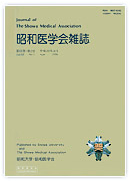All issues

Successor
Volume 71 (2011)
- Issue 6 Pages 515-
- Issue 5 Pages 445-
- Issue 4 Pages 365-
- Issue 3 Pages 207-
- Issue 2 Pages 103-
- Issue 1 Pages 1-
Volume 71, Issue 5
Displaying 1-10 of 10 articles from this issue
- |<
- <
- 1
- >
- >|
Feature Articles: Organ Regeneration
-
[in Japanese]2011 Volume 71 Issue 5 Pages 445-446
Published: October 28, 2011
Released on J-STAGE: August 03, 2012
JOURNAL FREE ACCESSDownload PDF (170K) -
[in Japanese], [in Japanese]2011 Volume 71 Issue 5 Pages 447-452
Published: October 28, 2011
Released on J-STAGE: August 03, 2012
JOURNAL FREE ACCESSDownload PDF (449K) -
[in Japanese], [in Japanese]2011 Volume 71 Issue 5 Pages 453-458
Published: October 28, 2011
Released on J-STAGE: August 03, 2012
JOURNAL FREE ACCESSDownload PDF (379K) -
[in Japanese], [in Japanese], [in Japanese], [in Japanese], [in Japane ...2011 Volume 71 Issue 5 Pages 459-464
Published: October 28, 2011
Released on J-STAGE: August 03, 2012
JOURNAL FREE ACCESSDownload PDF (721K) -
[in Japanese]2011 Volume 71 Issue 5 Pages 465-470
Published: October 28, 2011
Released on J-STAGE: August 03, 2012
JOURNAL FREE ACCESSDownload PDF (738K)
Final Lecture
-
[in Japanese]2011 Volume 71 Issue 5 Pages 471-481
Published: October 28, 2011
Released on J-STAGE: August 03, 2012
JOURNAL FREE ACCESSDownload PDF (416K)
Graphic
-
[in Japanese], [in Japanese], [in Japanese], [in Japanese], [in Japane ...2011 Volume 71 Issue 5 Pages 483-485
Published: October 28, 2011
Released on J-STAGE: August 03, 2012
JOURNAL FREE ACCESSDownload PDF (659K) -
[in Japanese], [in Japanese], [in Japanese], [in Japanese], [in Japane ...2011 Volume 71 Issue 5 Pages 487-489
Published: October 28, 2011
Released on J-STAGE: August 03, 2012
JOURNAL FREE ACCESSDownload PDF (497K)
Material
-
Nanako TAKAHASHI, Tsutomu YASUHARA, Kazuhide GOMI, Kunihiko FUKUCHI, K ...2011 Volume 71 Issue 5 Pages 490-496
Published: October 28, 2011
Released on J-STAGE: August 03, 2012
JOURNAL FREE ACCESSWe report the isolation of multidrug resistant Pseudomonas aeruginosa (MDRP), extended-spectrum-β-lactamase (ESBL)-producing Escherichia coli, ESBL-producing Klebsiella pneumoniae, ESBL-producing Klebsiella oxytoca and multidrug-resistant Acinetobacter baumannii in Showa University Hospital (Fiscal Year 2006-2010). MDRP were identified as 1 to 5 strains monthly, corresponding to 0.5-6% of total P aeruginosa isolates. ESBL-producing E. coli were identified as 10-40 strains monthly, 10-20% of total E. coli isolates. ESBL-producing E. coli occupied most of the third generation cephalosporin-resistant E. coli. From 10-20% of total K. pneumoniae isolates showed resistance to the third generation cephalosporin. About half of the third generation cephalosporin-resistant K. pneumoniae, 2-4 strains monthly, were identified as ESBL producing. From 10-20% of total K. oxytoca isolates showed resistance to the third generation cephalosporin-resistant, 2-6 strains monthly. ESBL producing strain. The number of MDRP and ESBL producing strains and the ratio to total isolates did not fluctuate from FY2006 to 2010. Ten to twenty strains of A. baumannii were isolated monthly in FY2010. Strains resistant to three antibiotic groups; Carbapenems, Aminoglycosides and Fluoroquinolones, were detected in 6 specimens of 4 patients in FY2010. Among them, 2 strains from 1 patient were resistant to Imipenem, Amikacin and Ciprofloxacin, and were identified as a definitive MDRA. The remaining 4 strains from 3 patients were resistant to Meropenem, Gemtamicin, and Ciprofloxacin, and were sensitive to Imipenem and Amikacin. To prevent the spread of drug-resistant bacteria, appropriate reporting efforts are necessary. Further, a sensitive method to detect drug-resistant strains using gene analysis should be established.View full abstractDownload PDF (526K)
Original
-
Terumasa SAWADA, Satoko UCHIDA, Noriko MIWA, Hiroto OYAMA, Rena SHIGEN ...2011 Volume 71 Issue 5 Pages 497-504
Published: October 28, 2011
Released on J-STAGE: August 03, 2012
JOURNAL FREE ACCESSPurpose: It is often discussed as to whitch of the following methods is the best to identify sentinel lymph nodes (SLN): the single dye method, the ICG fluorescence method, the radioisotope (RI) used alone, or the dye + RI method. However, to date, no conscious has been reached. In our institute Sentinel lymph node biopsy (SLNB) by the ICG fluorescence-method has been performed from April 2005. The results of SLNB should be reviewed for future clinical application. Object and methods: A total of 409 patients underwent primary breast cancer resection with SNLB by the ICG fluorescence method. Patients were divided into two groups for review. The first group: it was defined the whole period as the span to identify SLN from April 2005 in December to March 2010, and 2nd group: It was the 1st period (214 cases) that only patients who had an agreement for axillary lymph nodes dissection were examined correlation with false negative rate or others from April 2005 to March 2007. Results: During the first period, 81 patients underwent primary breast cancer resection with axillary lymph nodes dissection (ALND). Of these 81 cases, 42 cases (T1, tumor diameter < 2cm) had 0% false negative rate, 26 cases (Tumor size > 2cm) had 44% false negative rate. In 409 out of 410 cases (99.8%), SLN could be detected by ICG fluorescence method. Of the 409 cases, 314 cases were negative SLN metastases; of the 314 cases, 4 cases were revealed to have recurrence (distant or local) and 3 cases were found to have lymph node metastases inside breast tissue. Conclusion: Clinical advantage of this ICG fluorescence method is that it is easily workable for all surgeons and it does not require the use of Radioisotope controlled area. As for our results with the ICG method, the identification rate of SLN was higher than that for the single dye method and it is highly reliable. However, if the SLN is in breast tissue, not in an axillary lesion, it was not detected by ICG method. Moreover ICG method has not been suitable for operation under local anesthesia, because the precise location of SLN could not be identified.View full abstractDownload PDF (562K)
- |<
- <
- 1
- >
- >|